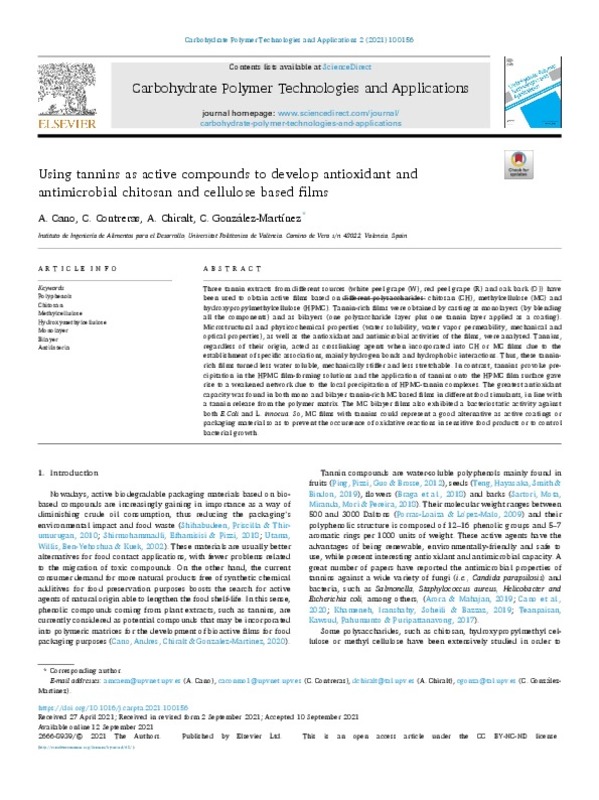JavaScript is disabled for your browser. Some features of this site may not work without it.
Buscar en RiuNet
Listar
Mi cuenta
Estadísticas
Ayuda RiuNet
Admin. UPV
Using tannins as active compounds to develop antioxidant and antimicrobial chitosan and cellulose based films
Mostrar el registro sencillo del ítem
Ficheros en el ítem
| dc.contributor.author | Cano, A.
|
es_ES |
| dc.contributor.author | Contreras Monzón, Carolina Ivonne
|
es_ES |
| dc.contributor.author | Chiralt Boix, Mª Amparo
|
es_ES |
| dc.contributor.author | González Martínez, María Consuelo
|
es_ES |
| dc.date.accessioned | 2022-05-03T18:04:16Z | |
| dc.date.available | 2022-05-03T18:04:16Z | |
| dc.date.issued | 2021-10-14 | es_ES |
| dc.identifier.uri | http://hdl.handle.net/10251/182381 | |
| dc.description.abstract | [EN] Three tannin extracts from different sources (white peel grape (W), red peel grape (R) and oak bark (O)) have been used to obtain active films based on different polysaccharides: chitosan (CH), methylcellulose (MC) and hydroxypropylmethylcellulose (HPMC). Tannin-rich films were obtained by casting as monolayers (by blending all the components) and as bilayers (one polysaccharide layer plus one tannin layer applied as a coating). Microstructural and physicochemical properties (water solubility, water vapor permeability, mechanical and optical properties), as well as the antioxidant and antimicrobial activities of the films, were analysed. Tannins, regardless of their origin, acted as crosslinking agents when incorporated into CH or MC films due to the establishment of specific associations, mainly hydrogen bonds and hydrophobic interactions. Thus, these tanninrich films turned less water soluble, mechanically stiffer and less stretchable. In contrast, tannins provoke precipitation in the HPMC film-forming solutions and the application of tannins onto the HPMC film surface gave rise to a weakened network due to the local precipitation of HPMC-tannin complexes. The greatest antioxidant capacity was found in both mono and bilayer tannin-rich MC based films in different food simulants, in line with a tannin release from the polymer matrix. The MC bilayer films also exhibited a bacteriostatic activity against both E.Coli and L. innocua. So, MC films with tannins could represent a good alternative as active coatings or packaging material so as to prevent the occurrence of oxidative reactions in sensitive food products or to control bacterial growth. | es_ES |
| dc.description.sponsorship | The authors acknowledge the financial support from the Spanish Ministerio de Economía y Competitividad through the project PID2019-105207RB-I | es_ES |
| dc.language | Inglés | es_ES |
| dc.publisher | Elsevier | es_ES |
| dc.relation.ispartof | Carbohydrate Polymer Technologies and Applications | es_ES |
| dc.rights | Reconocimiento - No comercial - Sin obra derivada (by-nc-nd) | es_ES |
| dc.subject | Polyphenols | es_ES |
| dc.subject | Chitosan | es_ES |
| dc.subject | Methylcellulose | es_ES |
| dc.subject | Hydroxymethylcellulose | es_ES |
| dc.subject | Monolayer | es_ES |
| dc.subject | Bilayer | es_ES |
| dc.subject | Antilisteria | es_ES |
| dc.subject.classification | TECNOLOGIA DE ALIMENTOS | es_ES |
| dc.title | Using tannins as active compounds to develop antioxidant and antimicrobial chitosan and cellulose based films | es_ES |
| dc.type | Artículo | es_ES |
| dc.identifier.doi | 10.1016/j.carpta.2021.100156 | es_ES |
| dc.relation.projectID | info:eu-repo/grantAgreement/AEI/Plan Estatal de Investigación Científica y Técnica y de Innovación 2017-2020/PID2019-105207RB-I00/ES/USO DE ACIDOS FENOLICOS PARA LA OBTENCION DE MATERIALES MULTICAPA ACTIVOS PARA EL ENVASADO DE ALIMENTOS/ | es_ES |
| dc.rights.accessRights | Abierto | es_ES |
| dc.contributor.affiliation | Universitat Politècnica de València. Instituto Universitario de Ingeniería de Alimentos para el Desarrollo - Institut Universitari d'Enginyeria d'Aliments per al Desenvolupament | es_ES |
| dc.contributor.affiliation | Universitat Politècnica de València. Departamento de Tecnología de Alimentos - Departament de Tecnologia d'Aliments | es_ES |
| dc.description.bibliographicCitation | Cano, A.; Contreras Monzón, CI.; Chiralt Boix, MA.; González Martínez, MC. (2021). Using tannins as active compounds to develop antioxidant and antimicrobial chitosan and cellulose based films. Carbohydrate Polymer Technologies and Applications. 2:1-9. https://doi.org/10.1016/j.carpta.2021.100156 | es_ES |
| dc.description.accrualMethod | S | es_ES |
| dc.relation.publisherversion | https://doi.org/10.1016/j.carpta.2021.100156 | es_ES |
| dc.description.upvformatpinicio | 1 | es_ES |
| dc.description.upvformatpfin | 9 | es_ES |
| dc.type.version | info:eu-repo/semantics/publishedVersion | es_ES |
| dc.description.volume | 2 | es_ES |
| dc.identifier.eissn | 2666-8939 | es_ES |
| dc.relation.pasarela | S\448280 | es_ES |
| dc.contributor.funder | AGENCIA ESTATAL DE INVESTIGACION | es_ES |
| dc.subject.ods | 12.- Garantizar las pautas de consumo y de producción sostenibles | es_ES |
| dc.subject.ods | 14.- Conservar y utilizar de forma sostenible los océanos, mares y recursos marinos para lograr el desarrollo sostenible | es_ES |
| dc.subject.ods | 15.- Proteger, restaurar y promover la utilización sostenible de los ecosistemas terrestres, gestionar de manera sostenible los bosques, combatir la desertificación y detener y revertir la degradación de la tierra, y frenar la pérdida de diversidad biológica | es_ES |








